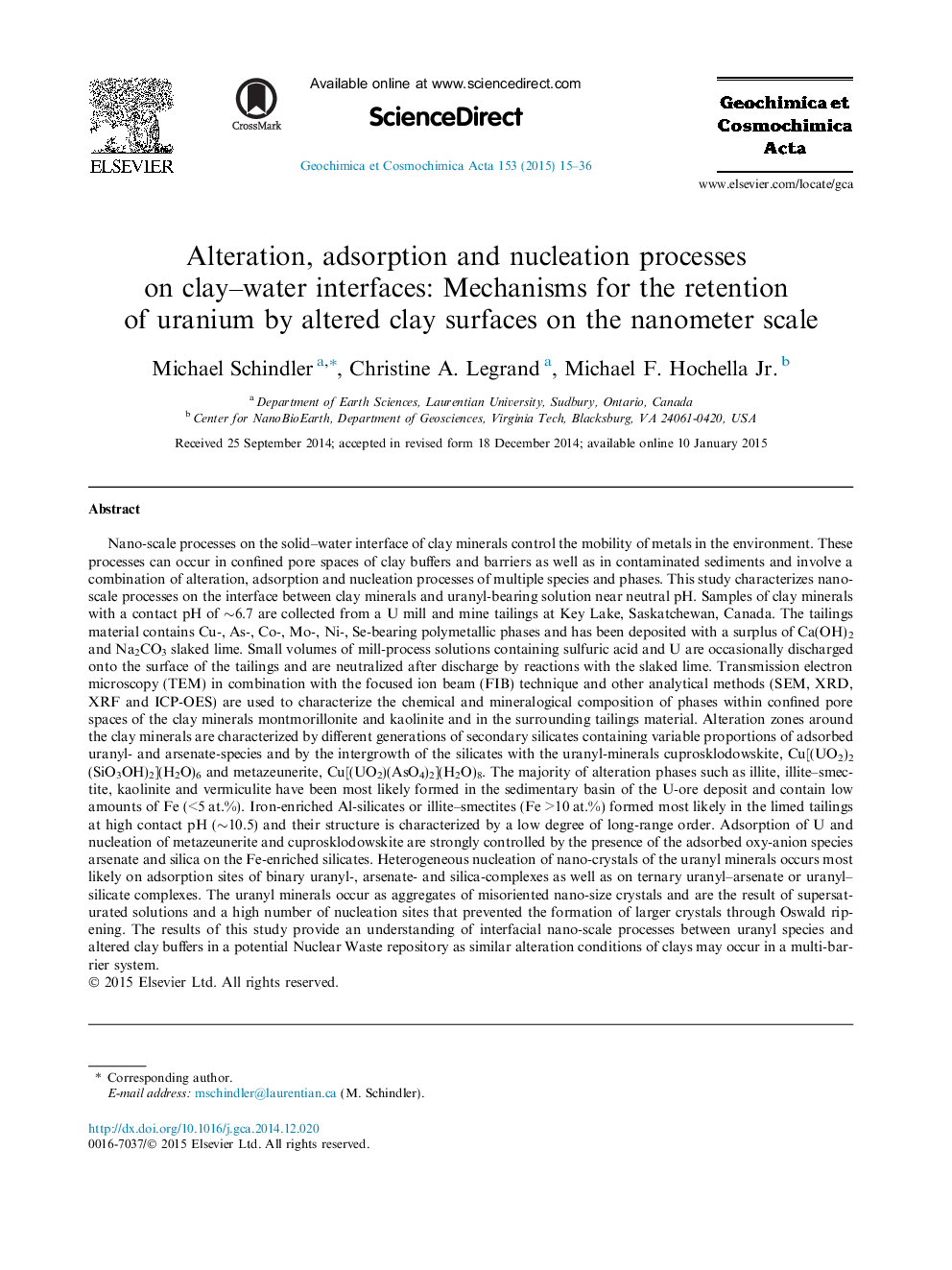| کد مقاله | کد نشریه | سال انتشار | مقاله انگلیسی | نسخه تمام متن |
|---|---|---|---|---|
| 4701967 | 1638004 | 2015 | 22 صفحه PDF | دانلود رایگان |
Nano-scale processes on the solid–water interface of clay minerals control the mobility of metals in the environment. These processes can occur in confined pore spaces of clay buffers and barriers as well as in contaminated sediments and involve a combination of alteration, adsorption and nucleation processes of multiple species and phases. This study characterizes nano-scale processes on the interface between clay minerals and uranyl-bearing solution near neutral pH. Samples of clay minerals with a contact pH of ∼6.7 are collected from a U mill and mine tailings at Key Lake, Saskatchewan, Canada. The tailings material contains Cu-, As-, Co-, Mo-, Ni-, Se-bearing polymetallic phases and has been deposited with a surplus of Ca(OH)2 and Na2CO3 slaked lime. Small volumes of mill-process solutions containing sulfuric acid and U are occasionally discharged onto the surface of the tailings and are neutralized after discharge by reactions with the slaked lime. Transmission electron microscopy (TEM) in combination with the focused ion beam (FIB) technique and other analytical methods (SEM, XRD, XRF and ICP-OES) are used to characterize the chemical and mineralogical composition of phases within confined pore spaces of the clay minerals montmorillonite and kaolinite and in the surrounding tailings material. Alteration zones around the clay minerals are characterized by different generations of secondary silicates containing variable proportions of adsorbed uranyl- and arsenate-species and by the intergrowth of the silicates with the uranyl-minerals cuprosklodowskite, Cu[(UO2)2(SiO3OH)2](H2O)6 and metazeunerite, Cu[(UO2)(AsO4)2](H2O)8. The majority of alteration phases such as illite, illite–smectite, kaolinite and vermiculite have been most likely formed in the sedimentary basin of the U-ore deposit and contain low amounts of Fe (<5 at.%). Iron-enriched Al-silicates or illite–smectites (Fe >10 at.%) formed most likely in the limed tailings at high contact pH (∼10.5) and their structure is characterized by a low degree of long-range order. Adsorption of U and nucleation of metazeunerite and cuprosklodowskite are strongly controlled by the presence of the adsorbed oxy-anion species arsenate and silica on the Fe-enriched silicates. Heterogeneous nucleation of nano-crystals of the uranyl minerals occurs most likely on adsorption sites of binary uranyl-, arsenate- and silica-complexes as well as on ternary uranyl–arsenate or uranyl–silicate complexes. The uranyl minerals occur as aggregates of misoriented nano-size crystals and are the result of supersaturated solutions and a high number of nucleation sites that prevented the formation of larger crystals through Oswald ripening. The results of this study provide an understanding of interfacial nano-scale processes between uranyl species and altered clay buffers in a potential Nuclear Waste repository as similar alteration conditions of clays may occur in a multi-barrier system.
Journal: Geochimica et Cosmochimica Acta - Volume 153, 15 March 2015, Pages 15–36
